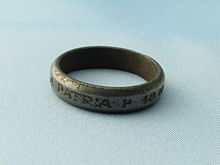Oro alla Patria
- Machine translation, like DeepL or Google Translate, is a useful starting point for translations, but translators must revise errors as necessary and confirm that the translation is accurate, rather than simply copy-pasting machine-translated text into the English Wikipedia.
- Consider adding a topic to this template: there are already 703 articles in the main category, and specifying
|topic=will aid in categorization. - Do not translate text that appears unreliable or low-quality. If possible, verify the text with references provided in the foreign-language article.
- You must provide copyright attribution in the edit summary accompanying your translation by providing an interlanguage link to the source of your translation. A model attribution edit summary is
Content in this edit is translated from the existing Italian Wikipedia article at [[:it:Oro alla Patria]]; see its history for attribution. - You may also add the template
{{Translated|it|Oro alla Patria}}to the talk page. - For more guidance, see Wikipedia:Translation.

Oro alla Patria ("Gold to the Homeland") was a 1935 Italian fascist campaign that asked Italians to donate their gold assets to fundraise for their homeland. Faced with League of Nations sanctions for its Second Italo-Ethiopian War, the Fascist government collected 250,000 wedding rings from Rome and 180,000 from Milan, amid other personal gold jewelry and objects totaling 33,600 kilograms of gold and 93,400 of silver. In acts of sacrifice for the state, prominent figures donated items of great symbolic value: the Queen's wedding ring, the Prince's collar of the Annunciation, the dramatist Luigi Pirandello's Nobel Prize, Guglielmo Marconi's senator medal, and Mussolini's Rocca delle Caminate castle statue busts.[2]
References
- ^ "New steel bands replace rings donated to Duce". The Patriot. Indiana, Pennsylvania. June 6, 1936. p. 8. Archived from the original on December 21, 2022. Retrieved December 21, 2022.
- ^ Innocenti, Marco (December 14, 2007). "Storie dalla storia / L'oro alla Patria". Il Sole 24 Ore (in Italian). Archived from the original on December 21, 2022. Retrieved December 21, 2022.
Further reading
- Terhoeven, Petra (2006). Oro alla patria: donne, guerra e propaganda nella giornata della fede fascista. Biblioteca storica / Il mulino (in Italian). Bologna: Il mulino. ISBN 978-88-15-11416-7. OCLC 799492207.
- Quirico, Domenico (2002). Squadrone bianco: storia delle truppe coloniali italiane. Le scie. Milano: Mondadori. ISBN 978-88-04-50691-1
- Petacco, Arrigo (2005). Faccetta nera: storia della conquista dell'impero (in Italian). Mondadori. ISBN 978-88-04-54761-7










